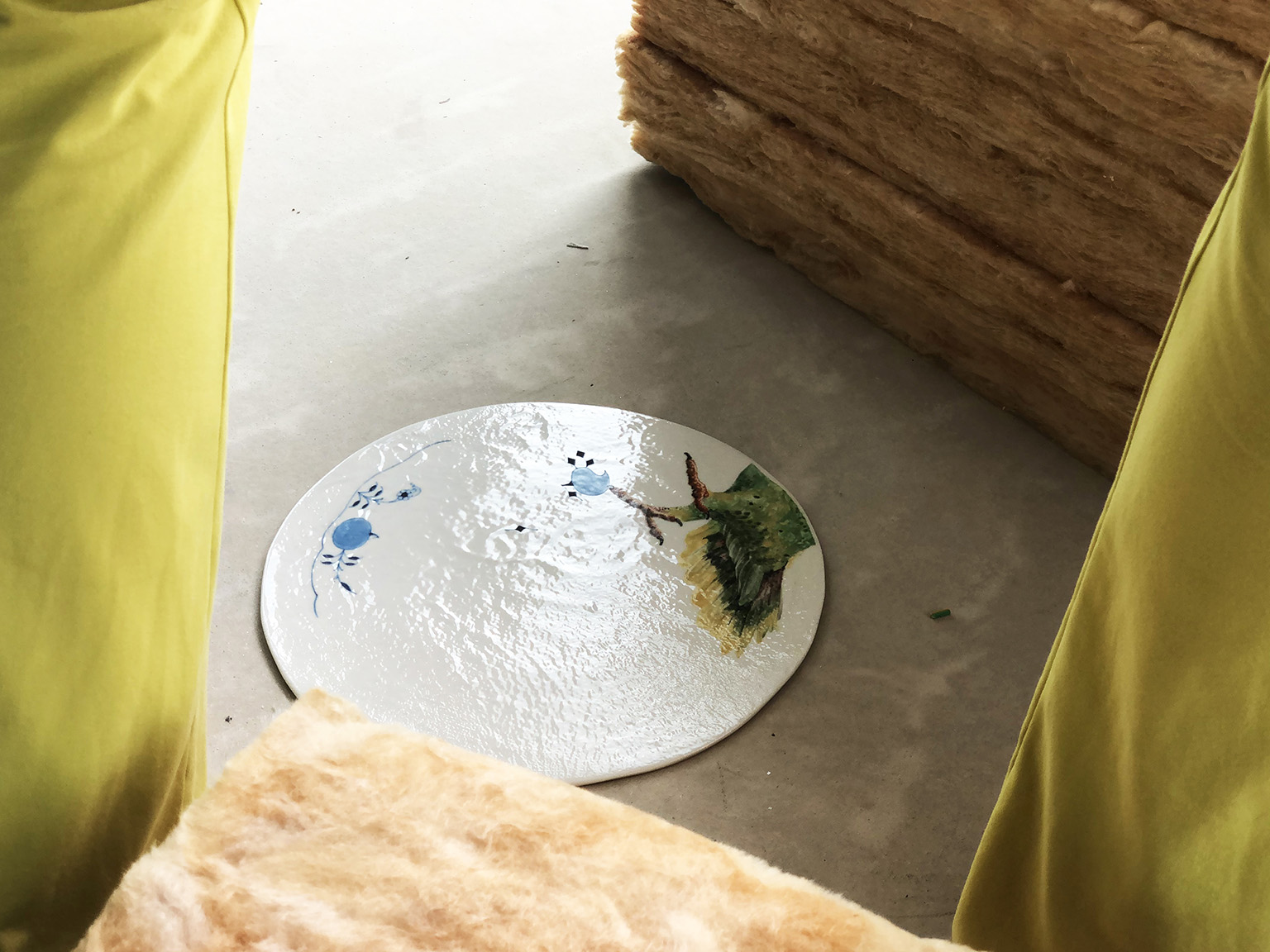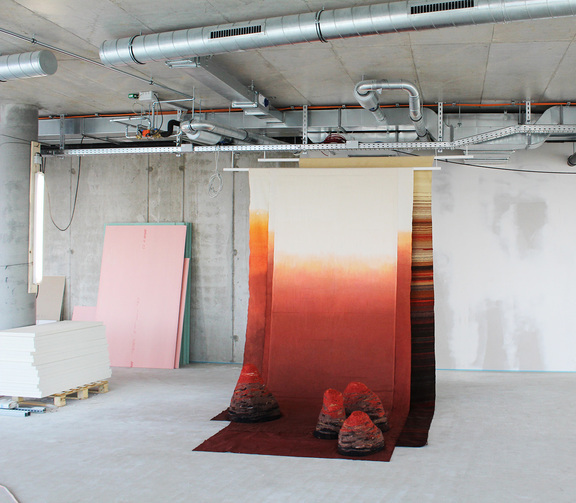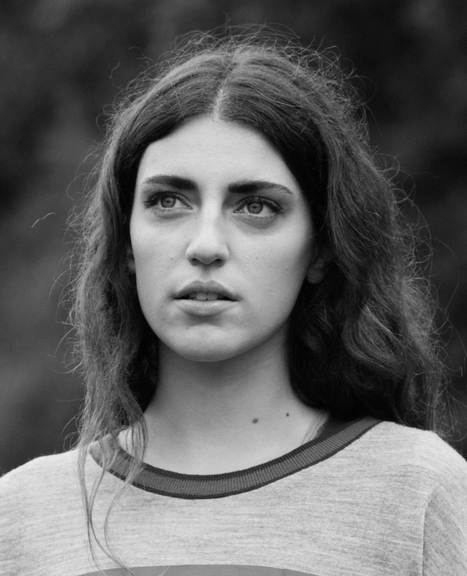
Art, public space and serendipities
“’What is public art?’ It is a huge question on the same level as ‘What is love?’”, reflects Jad El Khoury from Lebanon on studying Art and Public Space at KHiO. Together with Sarah Sekles from Germany, El Khoury is part of a group of only eight students, growing as artists through building international networks meeting professionals and exhibiting in and outside the school. And experiencing the serendipities that makes things come full circle.
“When I first arrived at KHiO, I was positively overwhelmed. It was a big place with many things to learn and understand,” says Sarah Sekles, who came from Germany to start her Master’s studies at KHiO autumn 2021. “I wasn’t very familiar with the school itself but I knew about the programme I wanted to apply to. Our Master’s group is small so it was easy to feel welcome, and we got a proper introduction to the school and our programme by our teachers. After one semester at KHiO I feel there is a strong support system here among students. It truly feels like the right place to be.”
Before Sarah started her studies at KHiO, she took a BFA in design at Berlin University of the Arts.
 “The school in Berlin has a strong focus on art, and the design programme is very open, not strongly consumption-based but more research-based. My final exam project highlighted certain material objects that underpin who I am. I had an intense research phase looking at my family roots. Much of what I learned justifies the selection, methodology and results of the final object collection, which consisted of clay works, foam sculptures, textile designs, colour compositions, paintings, poetry collages and botanical images – all making my personal story or experience visible.”
“The school in Berlin has a strong focus on art, and the design programme is very open, not strongly consumption-based but more research-based. My final exam project highlighted certain material objects that underpin who I am. I had an intense research phase looking at my family roots. Much of what I learned justifies the selection, methodology and results of the final object collection, which consisted of clay works, foam sculptures, textile designs, colour compositions, paintings, poetry collages and botanical images – all making my personal story or experience visible.”

Jad El Khoury from Lebanon, who is in his second year of the Master’s programme, had already worked professionally for several years on art in public space in several countries before he decided to apply to KHiO.
 “I was born in Lebanon two years before the end of the civil war. When I was two months old, our house was hit by a bomb and my parents have told me how they saw me fly up in the air from my crib. I belong to the first post-war generation – raised by a traumatised generation. Christians and Muslims were divided during 15 years of civil war, and after that 30 years of clientelism and sectarianism. We don’t want this separation any longer. I have studied architecture, and the basis of my work is abandoned buildings. The abandoned buildings in my country give fuel to war survivors’ traumatised memories. I see the buildings as representations of failure. I started to mix architecture and art through temporary installations, hanging up curtains on the windows of empty buildings. The wind changes them into choreographed installations dancing in the wind. This has given me the opportunity to travel and make installations in places like Corsica, Dunkirk and Stavanger and several other locations. After a while I felt I needed some space to feel safe, detach myself and rethink my priorities. I had heard of the school from my good frien Ahmed Badry who studied Medium- and Material-based Art here at KHiO and decided to apply.”
“I was born in Lebanon two years before the end of the civil war. When I was two months old, our house was hit by a bomb and my parents have told me how they saw me fly up in the air from my crib. I belong to the first post-war generation – raised by a traumatised generation. Christians and Muslims were divided during 15 years of civil war, and after that 30 years of clientelism and sectarianism. We don’t want this separation any longer. I have studied architecture, and the basis of my work is abandoned buildings. The abandoned buildings in my country give fuel to war survivors’ traumatised memories. I see the buildings as representations of failure. I started to mix architecture and art through temporary installations, hanging up curtains on the windows of empty buildings. The wind changes them into choreographed installations dancing in the wind. This has given me the opportunity to travel and make installations in places like Corsica, Dunkirk and Stavanger and several other locations. After a while I felt I needed some space to feel safe, detach myself and rethink my priorities. I had heard of the school from my good frien Ahmed Badry who studied Medium- and Material-based Art here at KHiO and decided to apply.”

A safe environment for making art
“I'm grateful for the Aker river that runs by our school with its waterfall and to have nature close by,” Jad says, sitting in a classroom whose huge windows overlook the river, which rushes past and makes you feel like you’re hovering over it. “We’re an international community of artists. Each student is completely different and we learn from each other, we learn from diversity. The workshop facilities here are very good and available to the students, also after hours, so I think it’s very important to use this opportunity and try out things in the workshops. I also really need the theory part of the programme. I’m developing my research methods and integrating text as part of my projects, and not only to describe a project. We have had the chance to attend readings and lectures with star guests like Morgan Puett, Mark Dion and Katie Paterson as part of a joint class between KHiO and the Chicago Art Institute, organised by Associate Professor Merete Røstad through her ongoing collaboration with Mary Jane Jacob.”
Sarah explains that her interest in Scandinavia motivated her to apply to schools here.
“During the interview process I had a very positive experience of openness – it was the most friendly and supporting interview I attended. And I didn’t find this specific course on art and public space anywhere else. Public spaces are often the starting point of my research and projects. I go to the places, document them, talk to the locals and find the spark that becomes the project. This has a strong impact on my artistic practice. In this Master’s programme I have learned how to properly communicate ideas and projects, especially underlining them with theory and contextualising my ideas. This has been very helpful to understand and clarify my thoughts also for myself.”
“KHiO as a whole has taught me to not be afraid of art and making art. The environment is very supportive and encouraging, and that helps me very much to constantly try out new things and be brave enough and not fear rejection or criticism. It’s a very safe environment when it comes to producing art.”

Public art – what is it?
“‘What is public art?’ That is a huge question on the same level as ‘What is love?’,” Jad reflects. “To me it’s the physical space in the city that anyone has free access to, and I focus on site-specific art that talks to the general public. For any physical installation in public spaces, the aesthetic elements, such as scale, colour and balanced composition, are very important in this fast-paced world we live in. There must be an instant grab of attention to make people stop for a second and take in the second layer of aesthetics, which is the collage of experiences and narratives I try to communicate in relation to the contextual and the personal. Both in the past and in the present, tyrants have used statues, huge posters and portraits for political reasons, and I feel the urgency to challenge this ongoing use of art in public space. The 2020 Beirut explosion on the 4th of August, when a large amount of ammonium nitrate exploded at the harbour, happened just two days before I left for KHiO. It gave me a taste of the war pain and trauma my parents’ generation suffered, and it reinforced my perception of failure and the need to challenge the system.”
“I agree, the communication side becomes more important,” Sarah adds. “Public art can also be inside a gallery about a specific site or public space. That is why the Master’s programme is called Art and Public Space, not Art in Public Space.”

Serendipities
As in previous years, both MA1 and MA2 are given the opportunity to exhibit outside of KHiO, this year at Gallery F15. The students have already visited the place, walked in the surrounding area and talked to people they’ve met to find their individual project connected to the location. As they haven’t quite decided on their projects, there is not yet much to show, but Jad talks about his experience from last years’ exhibition.
“Last year we had the great opportunity to exhibit outside of KHiO at the opening of the Nitja contemporary art centre. The exhibition Welcome to the Jungle* The exhibition was about urban development, so I went on lots of walks looking for my project. One day I passed a wooden house that winked at me with the same type of curtains I have used in my previous projects. The house was about to be demolished, so I asked the company performing the job if I could have some of the wooden panels, the curtains and some other building materials from the house. At Nitja I rebuilt part of the winking house with its curtains. A classmate had done a project on a rehabilitation centre and invited some people from the centre. Jarle was one of the people living there – he had had several strokes. Suddenly he stopped at the house and said, ‘This is my house!’ And it really was his house – he recognized it due to the window curtain. And the big reveal was that Jarle is a winking man himself, since he has one eye which is paralysed, because of his health problems, from the trauma and pain after serving as a UN soldier in Lebanon! Suddenly, the circle was closed, the connection between the personal and contextual was made, and it all made sense.”
 Read
Read
SERENDIPITY
Winking man finding his Winking house by Jad El Khoury
Follow on Instagram
Jad El Khoury @jadelkhoury.art
Master in Art and Public Space @maps_artandpublicspace
See more www.instituteforartandpublicspace.no
Unique, inclusive and international
Interview with Professor Siri Hermansen, head of the Master of Art and Public Space programme
The application deadline for the MFA in Art and Public Space is 1 February 2022.













